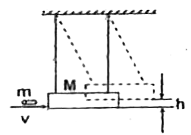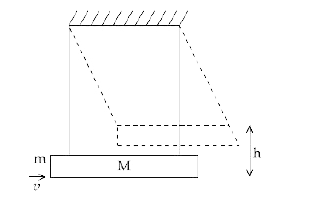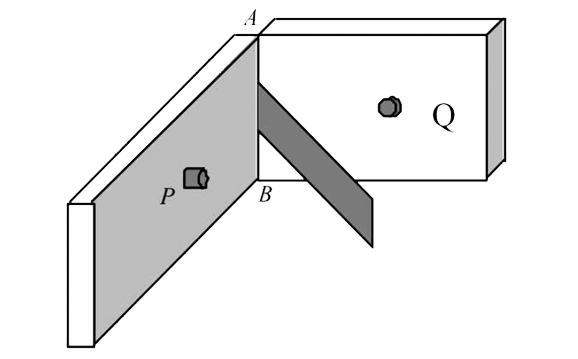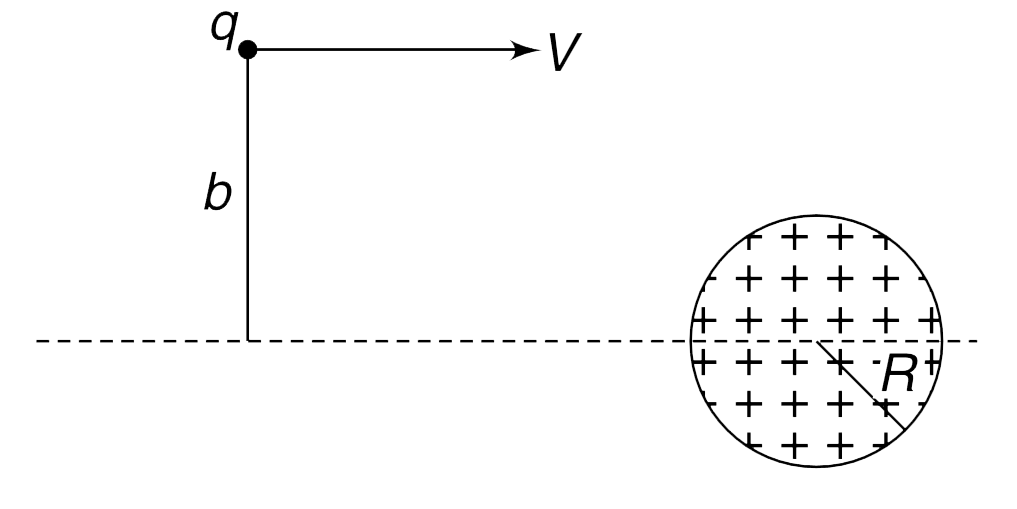A bullet is fired from a rifle, emerging from the muzzle at 340 metres per second. It strikes a sandbag some distance away, having lost 10 percent of its velocity due to air resistance. If it penetrates the sandbag to a depth of 12.0 centimeters, how long did it take for the bulletto come to rest in the sandbag
8×10−4s
2×10−4s
6×10−4s
4×10−4s
The correct Answer is:A
Having lost 10 percent of its speed, the bullet enters the sandbag at 0.9×340=306m/s. Camoing from that speed to rest, its average speed must have been half of 306 m/s, or 153 m/s. then
t=sv=0.12m153m/s=8×10−4s.
Topper's Solved these Questions
- BOOK - MTG IIT JEE FOUNDATIONCHAPTER - MOTIONEXERCISE - Exercise (Match the Following)4videos
MOTION
- BOOK - MTG IIT JEE FOUNDATIONCHAPTER - MOTIONEXERCISE - Exercise (Assertion & Reason Type)10videos
MOTION
- BOOK - MTG IIT JEE FOUNDATIONCHAPTER - MOTIONEXERCISE - Exercise (MCQ.s) Level-130videos
MOTION
- BOOK - MTG IIT JEE FOUNDATIONCHAPTER - GRAVITATION EXERCISE - Olympiad/HOTS Corner20videos
GRAVITATION
- BOOK - MTG IIT JEE FOUNDATIONCHAPTER - SOUNDEXERCISE - Olympiad/HOTS Corner15videos
SOUND
Similar Questions
A frequently used device to measure the speed of bullets is the ballistic pendulum. It comprises of a heavy block of wood of mass M suspended by two long chords. A bullet of mass m is fired into the block horizontally. The block, with the bullet embedded in it, swings upwards. The centre of mass of the combination rises through a vertical distance h before coming to rest momentarily. In a particular experiment, a bullet of mass 40 gm is fired into a wooden block of mass 10 kg. The block is observed to rise by a height of 20.0 cm.

If the bullet penetrates the block to a depth of 3.0 cm, the approximate average force of resistance by the block of wood isView SolutionA shell, which is initially located at a distance of 40.4 m above a horizontal plane, is fired horizontally with a muzzle velocity of 285 m/s to strike a target on the horizontal plane. (a) How long does the projectile remain in the air? (b) At what horizontal distance from the firing point does the shell strike the plane? What are the magnitudes of the (c ) horizontal and (d) vertical components of its velocity as it strikes the ground?
View Solution
Knowledge Check
- Question 1 - Select One
A frequently used device to measure the speed of bullets is the ballistic pendulum. It comprises of a heavy block of wood of mass M suspended by two long chords. A bullet of mass m is fired into the block horizontally. The block, with the bullet embedded in it, swings upwards. The centre of mass of the combination rises through a vertical distance h before coming to rest momentarily. In a particular experiment, a bullet of mass 40 gm is fired into a wooden block of mass 10 kg. The block is observed to rise by a height of 20.0 cm.

If the bullet penetrates the block to a depth of 3.0 cm, the approximate average force of resistance by the block of wood isA8.2×104NB32.4×104NC64.8×104ND16.8×104N - Question 2 - Select One
A thief sees a jeep at a distance of 250m coming towards him at 36 km/h. Thief takes 5 second to realize that there is nothing but the police is approaching him by the jeep and start running away from police at 54km/h. But police realize after 10 secs. When the thief starts running away that he is actually a thief and gives chase at 72 km/h. How long after thief saw police did police catchup with him and what is the distance police had to travel to do so ?
A50 s, 1000 mB65 s, 1150 mC65 s, 1300 mD45 s, 1050 m - Question 3 - Select One
It is possible to take a high quality photograph of a very fast moving object by illuminating the object for quite a small fraction of a second. You may have come across photographs of a bullet penetrating a banana or an apple in many text books or magazines. This is called 'stop action' photography because the fast moving object travels a very short distance during the time of illumination. Harold Edgerton, the inventor of stroboscope, was a pioneer of this kind of photography. A normal photographic plate works properly if it receives an energy of 4J during the exposure. To release this energy in a very small fraction of time, huge amount of power is required. Such huge power can not be generated directly from a battery because of its high internal resistance. To produce such power a capacitor is used. The time in which a capacitor discharges can be very short. Although, theoretically it would take a long time for a capacitor to discharge completely, it discharges almost completely in about 10 time constant. Consider the following situation A capacitor of 200muF storing 4J energy is made to discharge through a flash light in 2ms. This setup is used to take the picture of a bullet moving at a speed of 100m/s Assume that the flash light acts as a resistor and there is no other resistance in the circuit.
If we use a lens of power 10 diopters, the lens to photographic plate distance is 15cm and the bullet moves perpendicular to the principal axis, what is the distance covered by bullet as seen on photographic plate.A1 cmB5 cmC10 cmD20 cm
A large block of wood of mass M=5.99 kg is hanging from two long massless cords. A bullet of mass m=10 g is fired into the block and gets embedded in it. The (block + bullet) then swing upwards, their centre of mass rising a vertical distance -9.8 cm before the (block+bullet) pendulum comes momentarily to rest at the end of its arc. The speed of the bullet just before collision is : (take g=9.8ms−2)
 View Solution
View SolutionTwo heavy metallic plates are joined together at 90∘ to each other. A laminar sheet of mass 30kg is hinged at the line AB joining the two heavy metallic plates. The hinges are frictionless. The moment of inertia of the laminar sheet about an axis parallel to AB and passing through its center of mass is 1.2 kg m2. Two rubber obstacles P and Q are fixed, one on each metallic plate at a distance 0.5m from the line AB. This distance is chosen so that the reaction due to the hinges on the laminar sheet is zero during the impact. Initially the laminar sheet hits one of the obstacles with an angular velocity 1 rad/s and turns back. If the impulse on the sheet due to each obstacal is 6 N-s,
(a) Find the location of the center of mass of the laminar sheet from AB.
(b) At what angular velocity does the laminar sheet come back after the first impact?
(c) After how many impacts, does the laminar sheet come to rest?
 View Solution
View SolutionTwo heavy metallic plates are joined together at 90∘ to each other. A laminar sheet of mass 30kg is hinged at the line AB joining the two heavy metallic plates. The hinges are frictionless. The moment of inertia of the laminar sheet about an axis parallel to AB and passing through its center of mass is 1.2 kg m2. Two rubber obstacles P and Q are fixed, one on each metallic plate at a distance 0.5m from the line AB. This distance is chosen so that the reaction due to the hinges on the laminar sheet is zero during the impact. Initially the laminar sheet hits one of the obstacles with an angular velocity 1 rad/s and turns back. If the impulse on the sheet due to each obstacle is 6 N-s,
(a) Find the location of the center of mass of the laminar sheet from AB.
(b) At what angular velocity does the laminar sheet come back after the first impact?
(c) After how many impacts, does the laminar sheet come to rest?
 View Solution
View SolutionThere is a fixed sphere of radius R having positive charge Q uniformly spread in its volume. A small particle having mass m and negative charge (–q) moves with speed V when it is far away from the sphere. The impact parameter (i.e., distance between the centre of the sphere and line of initial velocity of the particle) is b. As the particle passes by the sphere, its path gets deflected due to electrostatics interaction with the sphere.
(a) Assuming that the charge on the particle does not cause any effect on distribution of charge on the sphere, calculate the minimum impact parameter b0 that allows the particle to miss the sphere. Write the value of b0 in term of R for the case
12mV2=100.(kQqR)
(b) Now assume that the positively charged sphere moves with speed V through a space which is filled with small particles of mass m and charge – q. The small particles are at rest and their number density is n [i.e., number of particles per unit volume of space is n].
The particles hit the sphere and stick to it. Calculate the rate at which the sphere starts losing its positive charge dQdt. Express your answer in terms of b0
 View Solution
View SolutionPassage -2
Emerging markets account for more than half of world GDP on the basis of purchasing power according to the International Monetary Fund (IMF). In thel 890s it was about a third and in the late 1890s 30% of countries in the developing world managed to increase their output per person faster than America did, thus achieving what is called 'catch-up growth'. That catching up was somewhat lackadaisical. The gap closed at just 1.5% a year. Some of this was due to slower grower in America, most was not. The most impressive growth was in four of the biggest emerging economies Brazil, Russia, India and China (BRICS). These economies have grown in different ways and for different reasons. The remarkable growth of emerging markets in general and the BRICS in particular transformed the global economy in many ways. Some wrenching commodity prices soared and the cost of manufacturers and labour sank. A growing and vastly more accessible pool oflabour in emerging economies played a part in both wage stagnation and rising income inequality in rich ones. Global poverty rates tumbled. Gaping economic imbalances fuelled an era of financial vulnerability and laid the ground work for global crisis. The shift towards the emerging economies will continue. But its most tumultuous phase seems to have more or less reached its end. Growth rates have dropped, the nature of their growth is in the process of changing too and its new mode will have lesser direct effects on the rest of the world. The likelihood of growth in other emerging economies having an effect in the near future comparable to that of the BRICS in the recent past is low. The emerging giants will grow larger and theirranks in swell but their tread will no longer shake the Earth as it once did.
After the 1890s there followed 'convergence with a vengeance'. China's pivot towards liberalization- and global markets came at a propitious time in terms of pohtics, busmess and technology. Rich economies were feeling reletively relaxed about globalization and current account deficits. Amenca's booming and confident was little troubled by the growth of Chinese industry or by off-shoring jobs to India. And the technology etc., necessary'to assemble and maintain complex supply chains were coming into their own, allowing firms to spread their operations between countries and across oceans. The tumbling costs of shipping and communication sparked 'globalization's second unbounding' (the fiat was the simple ability to provide consumers in one place with goods from another). As longer supply chains infiltrated and connected places with large and fast growing working-age populations, enormous quantities of cheap new labour became accessible. In 2007 China's economy expanded by an eye-popping 14.2%. h1dia managed 10.1 % growth, Russia 8.5% and Brazil 6.1 %. The IMF now reckons there will be a slowdown in growth. China will grow by just 7.6% in 2013 h1dia by 5.6% and Russia and Brazil by2.5%. Other countries have impressive growth potential. 'Next 11' (N 11) which includes Bangladesh, Indonesia, Mexico, Nigeria and Turkey. But there are various reasons to think that this Nl 1 cannot have an impact on the same scale as that of the BRICS. The first is that these economies are smaller. The N 11 has a population of just over 1.3 billion, less than half that of the BRICS. The second is that the N 11 is richer now than the BRICS were back in the day. The third reason that the performance of the BRICS cannot be repeated is the very success of that performance. The world economy is much larger than it used to be twice as in real terms as it was in 1892 according to IMF figures. But whether or not the world can build remarkable era of growth will depend in large part on whether new giants tread a path towards greater global co-operation or stumble in times of tumult and in the worst case fight.
According to the passage which of the following is a reason for the author's prediction regarding N11 countries?View Solution
